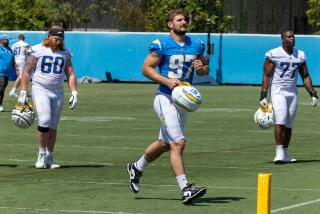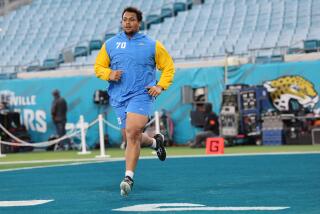Snaps, crackles and pops fill camp
- Share via
Pop! Philip Daniels goes down. Pop! Then Alex Buzbee.
Alvin Bowen, Oren O’Neal, Drew Carter, Mark Setterstrom, Daniel Sepulveda. Pop! Pop! Pop! Pop! Pop!
All of them are NFL players, with tendons and ligaments snapping apart, brittle as bone-dry rubber bands. All done for the season.
And there’s the pop heard ‘round the league: Osi Umenyiora, the most dynamic defensive player for the Super Bowl champion New York Giants, was carted off the field during an exhibition game Saturday against the New York Jets after his left knee “locked up” with what later was found to be a torn lateral meniscus. He too is finished before the season even started.
When it comes to severe injuries in the NFL, particularly to the knee, August is the cruelest month. Studies have shown that, and various experts have long pondered why the majority of season-ending injuries happen in training camp.
“When the season starts, other than the games themselves, the intensity during the season is not what it is in August,” said Dr. Neal ElAttrache, a joint specialist at the Kerlan-Jobe Orthopaedic Clinic. “So we’re in the peak month of ligament tears in the NFL.”
Those tears aren’t always the result of hits. In fact, players often go down with knee injuries because of high-speed cutting and torque on the knee, jumping for a pass and landing wrong.
ElAttrache said “probably 80%-90%” of anterior cruciate ligament tears are non-contact injuries.
That said, a lot of injuries are the result of contact, and one theory holds that players come into camp in such spectacular shape now -- as opposed to the days when players actually used the summers to get back into shape -- that the collisions are exponentially more violent from day one.
Because the NFL does not allow teams to conduct contact drills until training camp, players go from not hitting for months to suddenly slamming into each other dozens of times per practice, and that goes double for two-a-days.
“In the old days, guys used training camp to work their way slowly into shape,” longtime agent Leigh Steinberg said. “These guys today are in shape already, but they’re not in football shape. . . . It’s like running a car from 0 to 90 this fast.”
And sometimes, players’ seasons -- and occasionally their careers -- are finished just as fast. Injuries are part of the game, of course, but the league might want to look at its rules that prohibit contact in mini-camps.
Strange as it sounds, gradually building up hitting might help better prepare players for the molar-rattling crashes of camp. This summer, Steinberg called me and warned me to “Watch out for injuries in August.” Turns out, he was right.
It’s not that there are more injuries now than, say, last summer. But banged-up bodies are certainly a big story at this year’s camps.
New England quarterback Tom Brady is nursing a foot injury, and Indianapolis’ Peyton Manning is recovering from knee surgery, although neither injury was a result of training camp.
San Diego linebacker Shawne Merriman, among the league’s top five defensive players, is facing a knee injury that probably will end his season and could threaten his career. It’s no coincidence that the Chargers hustled this week to sign his backup, Jyles Tucker, to a five-year contract extension. They want him around if Merriman isn’t.
A study published last year in the American Journal of Sports Medicine showed that NFL players who suffer ACL tears are seldom the same type of player, production-wise, as they were before the injury. That’s assuming they were able to resume their careers, and one-fifth of those players couldn’t.
So what should teams do? Should they be on the constant lookout for equipment and surfaces that better protect their players? Should they hit less in camp? Hit more? Cross their fingers and pray?
The way Steinberg sees it, there’s only one sure thing.
The month’s not over. And the hits keep on coming.
--
More to Read
Go beyond the scoreboard
Get the latest on L.A.'s teams in the daily Sports Report newsletter.
You may occasionally receive promotional content from the Los Angeles Times.











